Amun, the Creator God, surpassed Egypt in supremacy

The world of the ancient Egyptians was diverse and enigmatic, filled with untold wonders and beliefs that were closely interwoven with the nature around them. Of particular interest is the vast Egyptian pantheon: hundreds upon hundreds of diverse gods and goddesses, protective spirits, and guardian animals, all formed an enormous web of deities.
But as with all pantheons, there are those gods that stand above the others – creator gods, bringers of life, and kings above all others. And one such god was Amun. He was king of the gods, the creator of life, and he was always one of the major deities of ancient Egypt. Apart from the Heliopolis Ogdoad – he sat at the very top of the pantheon. Today we are bringing to life the details of Amun, as we try to understand the Egyptians’ belief and reverence of this mighty bringer of life.
The Earliest Forms of Amun
In the vastness that is the Egyptian pantheon, which has well over 1,500 deities, Amun stands out as one of the most important and powerful gods. In ancient Egyptian belief, Amun was originally a part of the Ogdoad – a group of eight primordial deities. Amun emerged from the primordial watery abyss, the so-called Nu, or Nun, and from it created the world, and is as such a creator god.
The depictions of Amun were almost always universally the same – in his original form. He is presented as a tall man, with a pointed, pharaonic beard and wearing two tall plumes on his head. In his hands he holds the was scepter and the ankh. The was scepter was used to display dominion and power, while the ankh symbolizes life.
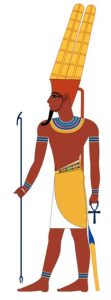
Typical depiction of the ancient Egyptian god Amun. (Jeff Dahl / CC BY-SA 4.0)
The name of Amun was in ancient Egyptian written as jmn, and it was transliterated in many forms, usually as Ammon, Amoon, Amun or Hammon. This name is translated into ‘invisible’, or ‘the hidden one’, emphasizing Amun’s mysterious and enigmatic nature. This also connects to his facet of being the invisible god of air and wind, or his role as the one who emerged from the primordial waters, as he was later depicted with blue skin to symbolize this.
Just like many gods of the Ogdoad, Amun had a consort. This was his wife, Amaunet, a primordial goddess. In the ancient Egyptian belief, it is a likelihood that Amaunet was not a deity of its own, but rather a different face of Amun himself, a dualistic complement to his role in the pantheon. Even so, some important pyramid texts mention Amun and Amaunet together, for example the pyramid text 446BC, which states:
“O Amun and Amunet! You pair of the gods, who joined the gods with their shadow!”
During the long history of Egypt, his cult grew and evolved, and thus we can see Amun depicted in several distinct forms beside his usual human one. One of these is the goose. This earns Amun the epithet of the “Great Shrieker”, and connects him with the primordial goose, the one which laid the ‘world egg’, and whose shriek was the first sound. Another form was Kematef (He Who Has Completed His Moment), a serpent with the head of a ram, or Kamutef (The Bull of His Mother), a lion with a ram’s head.
Another well attested form of Amun was that of a criosphinx, a sphinx with the head of a ram. This connected him with fertility. At other times he was portrayed as a lion, an ape, a human with a frog’s head and so on.
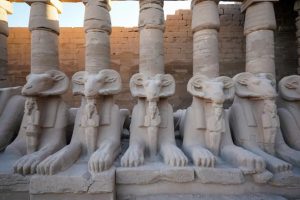
Statues of Amun in the form of a ram at Karnak Temple in Luxor, Egypt. Credit: Joanna Gillan
The Amun Cult Grew
Historically, Amun was not always worshiped prominently around Egypt. His cult grew in importance with the ongoing political developments. One of the earliest events that made Amun even more popular, happened around the time of the 11 th Dynasty (roughly 2130-1990 BC). The dynasty which hailed from Thebes (known as Waset to ancient Egyptians) brought to prominence their favored deities, and the chief of these was Amun.
A good insight into this is the historical names of some pharaohs and rulers, who often incorporated the name of Amun into their own, for example the founder of the 12 th Dynasty (1991-1802 BC), called Amenemhe (“God Amun is First”).
Later on, when the Theban royal 17 th Dynasty at last drove the Hyksos conquerors out of Egypt, their victory was dedicated to Amun the supreme god, and again his popularity rose.
There were several key monumental temples erected in glory of Amun, at various places and stages of Egyptian history. These included the three most important temples. One was the famous temple at Karnak. This magnificent complex is considered as the largest temple complex ever built by humans. And the central piece of this complex is the Great Temple of Amun. The procession way of Amun’s temple is lined with numerous criosphinxes.
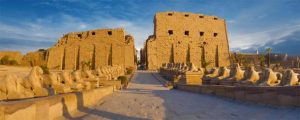
Great Temple of Amun, Karnak, Egypt. (Anton / Adobe stock)
Another temple was the one in today’s Deir el-Medina. Located on the western banks of the Nile, across Thebes, and very close to the famous Valley of the Kings. It was built by Ramesses II. And the third important temple is the Luxor Temple, originally built around 1400 BC and lays in the very heart of ancient Thebes. Here, Amun had another facet, being named Amenemope – or Amun of Opet.
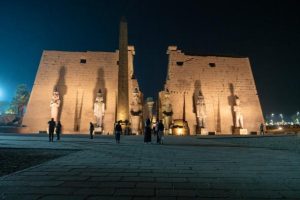
The Luxor Temple’s pylons and obelisk. Credit: Ioannis Syrigos
The Biggest Crisis
One of the unique pages of ancient Egyptian history was directly related to the worship of Amun, and was the period where the worship of this deity experienced its biggest crisis. This period was known as the Atenist Heresy, and it began in the 1 st Dynasty of the New Kingdom (the 18 th of ancient Egypt). It occurred when the pharaoh Akhenaten (Amenhotep IV) attempted to diminish the growing power of the Temple of Amun and its priests, by basing his religious worship solely on Aten, a deity symbolized by the Sun disk. Akhenaten’s name even means effective for Aten.
He proceeded to deface many old deities and basically constructed a monotheistic religion based on worship of Aten. The heresy ended with the death of Pharaoh Akhenaten, and his name was soon after struck from the records, and all his changes undone. His son and heir, who was named Tutankhaten (living image of Aten), was persuaded to change his own name into Tutankhamun (the living image of Amun).
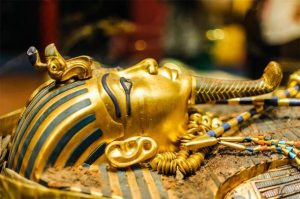
Mask of Pharaoh Tutankhamun. (Dieter Hawlan / Adobe stock)
Savior of Egypt, Vanquisher of Hyksos
This god reached the highest significance after the Hyksos invaders were driven out, and when his form was amalgamated with the Sun deity Ra, and he thus became known as Amun-Ra, or Amun-Re. Besides Osiris, Amun-Re is the most widely mentioned Egyptian deity. In this form he is mentioned as being the:
“Lord of truth, father of the gods, maker of men, creator of all animals, lord of things that are, creator of the staff of life.”
His form became depicted with the solar circle of Ra, and many votive stelae record him as a venerated god and protector of the poor and unfortunate. This was one of the reasons why he was glorified for the expulsion of the Hyksos invaders, as Egyptians were considering themselves as unfortunate, and relieved by Amun. One such votive inscription for the poor is just an example of many similar writings:
“Amun, who comes at the voice of the poor in distress, who gives breath to him who is wretched. You are Amun, the Lord of the silent, who comes at the voice of the poor; when I call to you in my distress, you come and rescue me… Though the servant was disposed to do evil, the Lord is disposed to forgive. The Lord of Thebes spends not a whole day in anger; His wrath passes in a moment; none remains. His breath comes back to us in mercy … May your kꜣ (ancient Egyptian for the soul) be kind; may you forgive; It shall not happen again…”
Another amalgamated form of Amun is that of Amun-Min, his symbiosis with Min, the god of fertility. As Amun-Min, the displayed form was largely that of Min – a black faced man covered in white shrouds and with his phallus erect, holding a flail that symbolizes dominance. The aspect of Amun was the addition of tall plumes on his head. In this form, Amun gained another epithet – Kamutef, or Bull of His Mother, the form of which was depicted on all major temples.
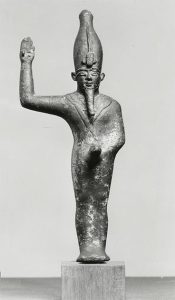
The representation of the mummiform Amun-Min-Kamutef with an erect phallus alludes to his role as a fertility god. His right arm is raised in a gesture of rejoicing, 7 th century BC. (Walters Art Museum / Public domain)
Amun Spreads Further Afield
Worship of Amun spread to other places outside the borders of Egypt, and it became venerated by many different cultures – at some places even more fervently than in Egypt. Good examples of this were Nubia and its Kingdom of Kush, where a form of Amun became a national deity. Here he was known as Amane and Amani, and had a widespread cult with priestly centers in Meroe and Nobatia.
In fact, the whole system of the kingdom was decided by an oracle of Amun. This oracle was seemingly in contact with the god, and could decide on matters of the highest importance, such as choosing rulers, demanding wars and military expeditions, and even commanding kings to commit suicide, as mentioned by Diodorus Siculus.
Another important place of worship of Amun was the Oasis of Siwa, known as the Field of Trees to the ancient Egyptians , which can be found between the Qattara Depression and the Great Sand Sea in the Libyan Desert, 50 km (30 mi) east of the Libyan border. Here stood a solitary temple to Amun with a single oracle. During the 26 th Dynasty, a necropolis was also established here, signifying its importance as a holy place.
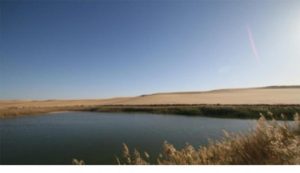
Siwa Oasis in the Modern day. (sulaiman / Adobe stock)
The nearby Greek colony in Libya, Cyrene, also came into contact with this solitary temple around 7th century BC, and the Greek writer Herodotus mentioned that the Amun was displayed in the form of a ram, which signifies his fertility and perhaps connects that to the fertility of an oasis in the middle of the desert.
Ancient Greece also worshiped the deity with much zeal, as Ammon, or Zeus Ammon. It is mentioned that both the peoples of Cyrene and Sparta went to the Siwa Oasis and consulted the oracle there more than any other Greek citizens. In time he too received an amalgamated form, being known as Zeus Ammon, and combined with the chief Greek deity Zeus. In this form he had the classical human depiction of Zeus, albeit with ram’s horns.
Interestingly, several important Greek words derive from the name of Amun. Chief examples of this are words such as ammonia and ammonite. Ammonium Chloride was known as sal ammoniacus – Salt of Amun, as it was collected mostly from ancient Libya, near the Temple of Jupiter-Amun. Furthermore, a part of our brains known as hippocampus proper, is also known as cornu ammon, ‘horns of Amun’, due to their horn appearance.
Amun was much revered by the Greeks, so much so that even Alexander the Great came into contact with this deity when he travelled to the solitary oracle at Siwa, after the Battle of Issus. Some say that he managed to reach the oasis after following birds across the desert. The lonesome oracle told him that he was a divine person, and a legitimate pharaoh of Egypt, and the son of Amun. Some scholars state that Alexander thereafter considered himself as divine.
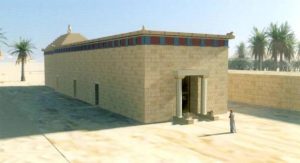
Reconstruction of the monument in the Siwa Oasis that Alexander the Great travelled to. (Liana Souvaltzi)
In the Footsteps of Gods
Even if the cult of Amun was significant all the way up to the 20 th Dynasty, and its priestly cult was at times very powerful, the worship of Amun gradually began to weaken, especially after the social unrests that came after the 20 th Dynasty, which lasted roughly from 1190-1077 BC. Lower and Upper Egypt again became increasingly divided, and Thebes lost its importance, and with it the major deity of the town, Amun.
Still, the worship of Amun remained at its height with the kings of Nubia, who revered him long after. But throughout the rest of Egypt, Amun was worshipped with significantly less zeal, and became somewhat overtaken by the cults of Isis and Osiris.
Amun and his cult provide a crucial glimpse into the complex religious beliefs of the ancient Egyptians, but also into the sociopolitical events throughout its history. From Nubia to Egypt, this important god found his way, and bolstered the hearts and the faith of those needy and pious, becoming the protector of the poor and the guardian of the oppressed.